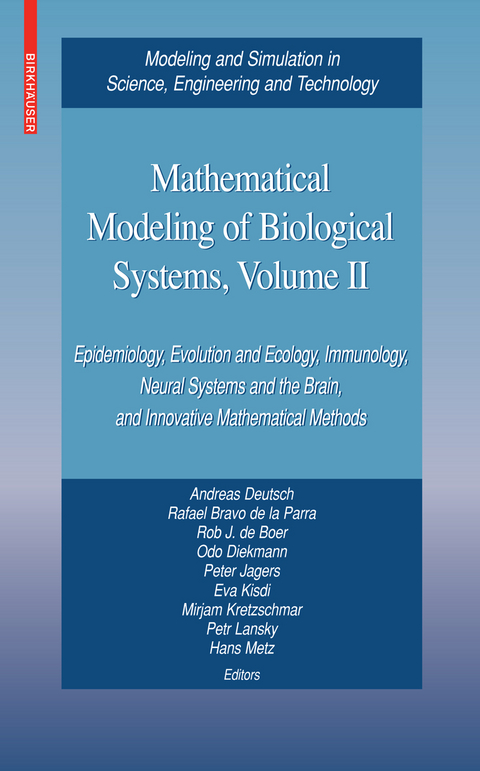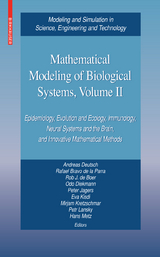Mathematical Modeling of Biological Systems, Volume II
Birkhauser Boston Inc (Verlag)
978-0-8176-4555-7 (ISBN)
This edited volume contains a selection of chapters that are an outgrowth of the - ropean Conference on Mathematical and Theoretical Biology (ECMTB05, Dresden, Germany, July 2005). The peer-reviewed contributions show that mathematical and computational approaches are absolutely essential to solving central problems in the life sciences, ranging from the organizational level of individual cells to the dynamics of whole populations. The contributions indicate that theoretical and mathematical biology is a diverse and interdisciplinary ?eld, ranging from experimental research linked to mathema- cal modelling to the development of more abstract mathematical frameworks in which observations about the real world can be interpreted and with which new hypotheses for testing can be generated. Today, much attention is also paid to the development of ef?cient algorithms for complex computations and visualization, notably in molecular biology and genetics. The ?eld of theoretical and mathematical biology and medicine has profound connections to many current problems of great relevance to society. The medical, industrial, and social interests in its development are in fact undisputable. Insights and predictions from mathematical modelling are used increasingly in de- sion support in medicine (e.g., immunology and spread of infectious diseases, cancer research, cardiovascular research, neurological research, optimization of medical tre- ments,imaging),environmentalandnaturemanagement,climateproblems,agriculture and management of natural resources. Fast developments in areas such as biotechn- ogy (e.g., genome projects, genetic modi?cation, tissue engineering) continue to add new focal points of activity to the ?eld. The contributions of this volume capture some of thesedevelopments.
Epidemiology.- Could Low-Efficacy Malaria Vaccines Increase Secondary Infections in Endemic Areas?.- Modeling of the Invasion of a Fungal Disease over a Vineyard.- An Algorithm for Parameter Estimation in Nosocomial Infections.- Evolution and Ecology.- Evolutionarily Stable Investment in Anti-Predatory Defences and Aposematic Signalling.- The Tangled Nature Model of Evolutionary Ecology: An Overview.- Relative Advantage and Fundamental Theorems of Natural Selection.- Competitive Exclusion Between Year-Classes in a Semelparous Biennial Population.- On the Impact ofWinter Conditions on the Dynamics of an Isolated Population.- Planning for Biodiversity Conservation Using Stochastic Programming.- A Diffusion-Reaction Model of a Mixed-Culture Biofilm Arising in Food Safety Studies.- The Periodical Population Dynamics of Lottery Models Including the Effect of Undeveloped Seeds.- Immunology.- An Automata-Based Microscopic Model Inspired by Clonal Expansion.- Th1–Th2 Regulation and Allergy: Bifurcation Analysis of the Non-Autonomous System.- Architecture of Randomly Evolving Idiotypic Networks.- Analysis of Infectious Mortality by Means of the Individualized Risk Model.- Neural Systems and the Brain.- Neuromorphological Phenotyping in Transgenic Mice: A Multiscale Fractal Analysis.- A Quantitative Model of ATP-Mediated Calcium Wave Propagation in Astrocyte Networks.- Dynamics of Neural Fields with Distributed Transmission Speeds.- Estimation of Differential Entropy for Positive Random Variables and Its Application in Computational Neuroscience.- Dynamics of Integrate-and-Fire Models.- A Monte Carlo Method Used for the Identification of the Muscle Spindle.- Mechanisms of Coincidence Detection in the Auditory Brainstem: Examples.- Multi-Scale Analysis of Brain Surface Data.-The Spike Generation Processes: A Case for Low Level Computation.- Innovative Mathematical Methods and Education.- Offdiagonal Complexity: A Computationally Quick Network Complexity Measure—Application to Protein Networks and Cell Division.- An Analytically Solvable Asymptotic Model of Atrial Excitability.- A Bayesian Approach to the Quantitative Polymerase Chain Reaction.- A Model of Poplar (Populus sp.) Physiology and Morphology Based on Relational Growth Grammars.- Asymptotic Behavior of a Two-Dimensional Keller–Segel Model with and without Density Control.- Saturation Effects in Population Dynamics: Use Branching Processes or Dynamical Systems?.- Modelling and Simulation by Stochastic Interacting Particle Systems.- Teaching Mathematical Biology in a Summer School for Undergraduates.
| Reihe/Serie | Modeling and Simulation in Science, Engineering and Technology |
|---|---|
| Zusatzinfo | XVIII, 386 p. |
| Verlagsort | Secaucus |
| Sprache | englisch |
| Maße | 156 x 234 mm |
| Themenwelt | Informatik ► Weitere Themen ► Bioinformatik |
| Mathematik / Informatik ► Mathematik ► Angewandte Mathematik | |
| Naturwissenschaften ► Biologie | |
| ISBN-10 | 0-8176-4555-1 / 0817645551 |
| ISBN-13 | 978-0-8176-4555-7 / 9780817645557 |
| Zustand | Neuware |
| Haben Sie eine Frage zum Produkt? |
aus dem Bereich




